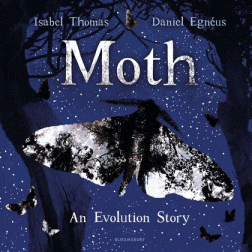
Moth: An Evolution Story
Moth: An Evolution Story
Isabel Thomas
Daniel Egnéus
Bloomsbury, 2018
48pp., hbk., RRP $A24.99
9781408889756
In a clean, fresh world, a shiny cocoon wriggles and jiggles and a moth with salt-and-pepper wings emerges. But there is no time to languish – as daylight emerges, it must fly to the nearby trees with their lichen-covered branches where its colouring camouflages it from its predators – birds, bats and cats!
But some moths are born with charcoal wings, easy prey as their colouring makes them stand out . While they become food for hungry birds and their chicks, the speckled, freckled ones are safe in their disguise and the next night they lay eggs of their own, and their babies will be just like their parents.
But then the world began to change and coal-burning factories and steam-driven trains changed it to a dirty, dark place full of pollution which stained the clouds, and darkened the branches where the speckled, freckled ones rested. And they became the vulnerable ones while their charcoal friends were safe. So gradually, they changed and it was the dark-winged variety that was common and the salt-and-pepper ones became rare.
However, as people realised the harm they were doing, slowly the world began to change again – not quite as clean as before but so much better. And a miracle happened…
Encapsulated in this beautifully illustrated book is the story of the peppered moth, an example of natural selection and the theory behind process of evolution – creatures changing themselves to adapt to and survive in their changing environments. With its explanation of the moth’s story and extrapolating from that to all creatures including humans, this is the perfect introduction to Darwin’s theories and the impact of human intervention on the environment. Throughout though, there is hope – that we are not doomed as many would have us believe, but that we are changing and we must adapt to that change whilst doing all that we can to assist Mother Nature by keeping our planet pure and pristine because try as we might, not all creatures can adapt as readily and quickly as the moth does and the list of species, both fauna and flora, that have become extinct continues to grow.
A must in any library in a school that has students and staff concerned about the environment – what might be living in the playground that could use a bit of positive human intervention?